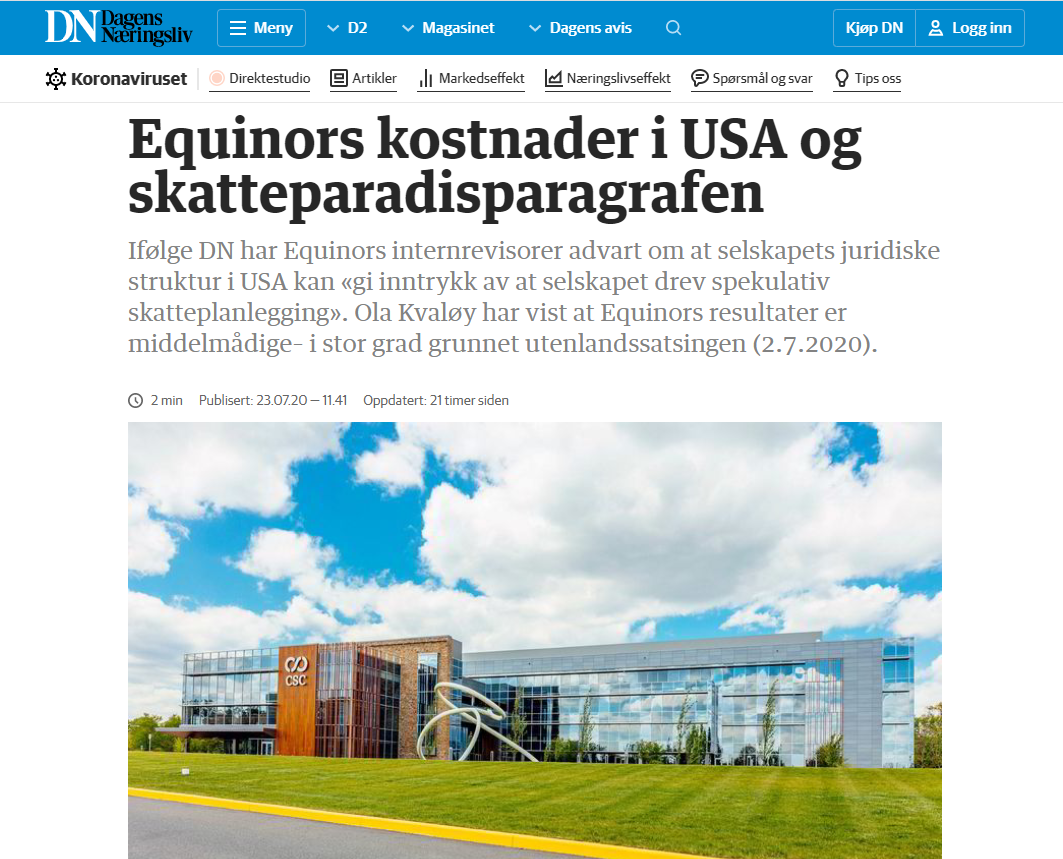
This opinion piece was written by PWYP Norway`s Secretary General Mona Thowsen and was first published in Dagens Næringsliv July 23,2020.
According to "Dagens Næringsliv", Equinor`s internal auditors have warned that the company`s legal structure in the US may “give the impression that the company conducted “speculative tax preparations”. Ola Kvaløy has revealed that Equinor`s profits were mediocre – largely due to foreign investment (July 2, 2020).
DN`s disclosure and Ola Kvaløy’s observation highlight the need to implement "extended country-by-country reporting".
PWYP Norway has analyzed Statoil/Equinor`s reporting under the regulation “country-by-country reporting” over five financial years: 2014, 2015, 2016, 2017 and 2018.
The costs in Statoil / Equinor have generally been hidden and thus impossible to track. Hidden costs prevent access and public discussion of important issues concerning the operation of public companies. Perhaps greater transparency and a more informed public discussion could lay the basis for better operations and less economic waste in the US investment.
"Country-by-country reporting" (CBCR) is a form of reporting initially used in the US and the EU. The regulations on CBCR were automatically introduced in Norway since Norway complies with EU regulations (from 1.1.2014). The regulations should ensure that those who extract non-renewable and limiting natural resources with high environmental costs, such as oil and gas, mining and forestry, are required to provide information on tax payments to the authorities. The purpose was to ensure that the individual country is held responsible for the correct reception of paid taxes, CBCR is thus an instrument against state corruption.
However, CBCR`s reporting only consisted of information on tax payments, and there was only a requirement to provide information to countries where the companies paid taxes. Since the CBCR reporting lacked information on the context of the tax payments, it could not be utilized to find information on potential tax evasion.
Also read: Equinor: Ble advart om inntrykk av spekulativ skatteplanlegging
(Equinor: Was warned about the impression of speculative tax planning.)
PWYP Norway and many others, however, want to know whether tax evasions are occurring. For this reason, PWYP Norway developed «extended country-by-country reporting (ECBCR).
ECBCR is a requirement for transparency from companies on specific accounting information related to the tax area which includes information on paid taxes and the context in which the taxes are included.
ECBCR includes an extended disclosure obligation on 8 key figures from the companies (production, employees, investments, income and expenses, as well as three figures for tax payments). The key figures are reported for each individual country where the company is present. Eventually, the regulations will hopefully also apply to fisheries and other sectors.
Through an «extended country-by-country reporting” we could acquire reliable information about the size of the investments in the United States and what the society gets in return for the investments.
In the amendment for country-by-country reporting §4, 2 paragraph it states “When required to provide information on payments to authorities the report shall contain information on the undertaking`s investments, sales revenue, production volume and expense, distributed among the individual countries where the undertaking is running their activity.”
Also read: Professor Ola Kvaløy vil ha uavhengig granskning av Equinor (Professor Ola Kvaløy wants an independent investigation of Equinor)
The requirement is made dependent on whether a company has paid taxes. Naturally, it is a problem here that the companies do not pay taxes in tax havens. If the information also must be reported from tax havens, then §4, 2 paragraph must be changed to “Regardless of whether there is a requirement to supply information on payments to the authorities.”
We showed in the 2014 analysis that Statoil had mixed in down-stream numbers in a report about up-stream numbers. In the 2015 analysis we showed that Statoil reported on the «purchase of goods and services” instead of “expenses”. In the 2016 analysis we showed that despite improvements, it was still not possible to analyse the expenses in a satisfactory manner. The 2017 analysis showed that eliminations continued to not be reported separately. Because of this it was not possible to reconcile among other expenses with the annual accounting. It was also not possible reconcile taxes in the accounts with paid taxes. In the 2018 analysis we showed that Equinor in some places had a down-right messy accounting. Equinor would benefit from including the information in the format PWYP Norway has proposed.
Also read: Skattedirektøren: Trenger ikke skatteparadiser for å hindre dobbeltbeskatning
(The Director of Taxes: Tax havens are unnecessary in order to prevent double taxation)
Expenses in the home country and in resource countries can easily be converted to revenue in tax havens. This is one of many ways capital flight can take place. It is easy for a group company to divide up the expenses and divide them into many sections, including tax havens, so that the control is pulverized. A company can easily combine expenses (just like revenue) with derivatives which allows the company to lock in a cost level that is higher than it is factually.
Tax authorities can control whether market prices are achieved in the home country. But it is more difficult to control expenses, at the same time it is easier to increase expenses than to reduce revenue, for the companies. This makes it difficult for the tax authorities to crack down even on large cost variations in the form of transfer mispricing. And when a company eliminates internal profits, that does not make the expenses higher in the company, but the taxes are “conjured away”. The state has a responsibility to ensure we have a taxation system that allows us a reasonable secure way to know what a company should pay in taxes.
This must be in place:
1. The reported numbers must come from the account.
2. Additional information must be provided in notes to the annual accouting. Eliminations must be reported separately.
3. Reported investments must reconcile with cash flow analysis.
